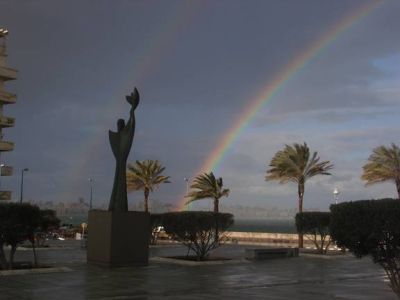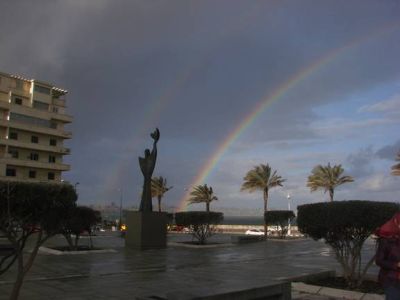16 February 2008

Double Rainbow over the BA
The picture shows two rainbows, the primary and secondary rainbows, also known as the double rainbow. The secondary rainbow lies outside the primary. Evidently, the sky inside the primary rainbow is much brighter than outside of it.
Photo by Aymen Ibrahem, Senior Astronomy Specialist
On the morning of 14 February 2008, heavy rain fell in Alexandria, Egypt. A bright rainbow gleamed over the BA. Observing from the BA Plaza, BA Senior Astronomy Specialist, Aymen Ibrahem, imaged the spectacular rainbow, and its fainter, larger twin, the secondary rainbow.
A rainbow is formed due to refraction and reflection of sunlight inside raindrops. Double reflection of sunlight inside the raindrops produces a secondary rainbow. The two rainbows are centered on the antisolar point, the point directly opposite to the Sun in the sky.
Due to double reflection, the secondary rainbow is fainter, and the order of the colors of the rainbow is reversed. So, in the primary rainbow, red is the outermost color, while in the secondary rainbow, violet is the outermost color. The reds of the primary and secondary rainbows always face each other. The primary and secondary rainbows are, respectively, 42, and 51 in radius.
“This double rainbow was one of the most beautiful celestial sights I have ever observed,” said Ibrahem. “During heavy rain, the gleaming rainbow emanated from the sea, and arched high in the sky. I was able to view the distant houses near the Qaitbay Citadel through the rainbow. A conspicuous secondary rainbow developed following the brightening of the primary.”
Ibrahem took intriguing images of the rainstorm, showing the rainy clouds, rainbows, and the behavior of animals. Some of his images are presented in the picture gallery below.
Picture Gallery

Fig (1)
Rainbow Segment
The picture shows a bright segment of a rainbow.
Photo by Aymen Ibrahem, Senior Astronomy Specialist

Fig (2)
A Brightening Rainbow
Photo by Aymen Ibrahem, Senior Astronomy Specialist

Fig (3)
A Dark Band
The picture shows the primary and secondary rainbows. Noticeable, the sky between the two rainbows is darker than outside of the rainbows. This effect is known as Alexander’s dark band. It is named in honor of Alexander of Aphrodisias who first described it in 200 AD.
Photo by Aymen Ibrahem, Senior Astronomy Specialist

Fig (4)
Alexandria through a Rainbow
The rainbow appeared to emanate from the sea. Distant houses near the Qaitbay Citadel are visible through the shimmering rainbow.
Photo by Aymen Ibrahem, Senior Astronomy Specialist

Fig (5)
Rainstorm Subsides
The rainstorm subsided by about 08:22 EET (06:22 GMT).
Photo by Aymen Ibrahem, Senior Astronomy Specialist
Further Reading
A Monochromatic Rainbow
../home/NewsDetail.aspx?Find=NJu9Pwqzd5bujLB7PbcOHg%3d%3d
A Spectacular Rainbow Wows Young Sky Observers
../home/NewsDetail.aspx?Find=spACZ0i1Wx8FqAtuqTaK6w%3d%3d
When Twilight Turned into Daylight
../home/NewsDetail.aspx?Find=nvZD65z43nEKF7n%2fCbVOcA%3d%3d
Bibliography
Atmospheric Optics (a famous website by Les Cowley)
Light and Optics: Online Meteorology Guide
Aymen Mohamed Ibrahem
Senior Astronomy Specialist